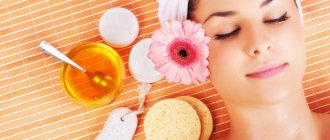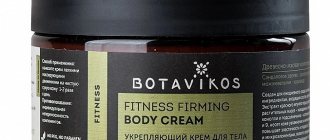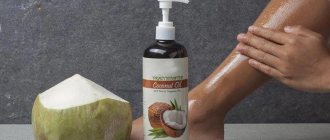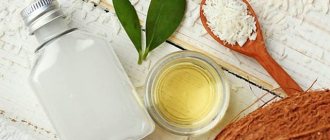Benefits of cosmetic oils
Why oil, you ask. You can use your usual cream according to your skin type, and not waste time preparing homemade masks. You are right about this.
However, you will have to pay a lot of money for high-quality cosmetics, while oils cost pennies. Any cream works only in the superficial layers of the skin, but a natural product penetrates into deep structures and works at the cellular level.
Cosmetics give a positive effect while you use them, and oils have a long-lasting effect.
In addition, the likelihood of developing an allergy is possible only if there is an individual intolerance to natural components. While the cream includes many chemical additives, the skin reaction is quite difficult to predict.
Although to be fair, if you decide to use cosmetic oil instead of cream, do not expect quick results. You will be able to enjoy beauty only after 2-3 weeks of regular procedures.
Harm from facial oil
Like any natural product, oil can cause individual intolerance and allergic reactions. Therefore, be attentive to your feelings and do a sensitivity test before first use. Place a small amount of oil on the crook of your elbow or on your wrist. Assess the reaction within 20-30 minutes. If redness, itching or other unpleasant symptoms do not occur, the risk of an allergy is minimal. What else could be unpleasant about using facial oil?
- May cause clogged pores. To avoid this, carry out regular cleaning procedures.
- If you find an oil that suits you and solves your problem, you can forever fall in love with natural cosmetology and lose interest in expensive cosmetics from well-known companies. Be careful!
Jojoba oil
The beneficial properties of jojoba are determined by its composition. Vitamin E stops the aging process, accelerates cell regeneration, and smoothes the microrelief. It has a lifting effect, restores lost elasticity, and protects against the negative effects of free radicals.
Other beneficial substances create a protective film on the skin, thereby preventing moisture loss and preventing the appearance of flaking. They give the product softening, moisturizing, nourishing and anti-inflammatory properties.
The product can be used for any type of skin. It solves especially well the problems of sensitive, dry and aging skin.
I want to share with you several recipes for simple but effective procedures. In order not to repeat myself, I will say right away: the duration of action of any mask described in the article is 20 minutes, the frequency of use is once every 3 days, unless other recommendations are indicated.
- For deep wrinkles. Mix jojoba product and avocado in equal quantities, spread the mixture over your face, leave for 20 minutes. A rejuvenation session must be carried out every day. For prevention – 1 time every 3 days, before bedtime;
- For nutrition and deep hydration. Combine jojoba and grape seed oil in a 1:1 ratio, add a drop of orange ether;
- For inflammation and acne. Add 2 drops of lavender and clove ether to 15 ml of base.
Essential oils for the face – Top 8
Essential oils for the face in their pure form are rarely used. If they are thick enough and greasy in consistency. For example, sandalwood oil. Different manufacturers may make it slightly differently, but usually it is suitable for caring for the area around the eyes and is excellent at smoothing out wrinkles.
More often it is recommended to mix them with basic ones or add them to face masks. The optimal ratio is 2-3 drops per teaspoon of base.
Sandalwood oil
Universal and optimal for dry and aging skin.
- It smooths out wrinkles, making them less noticeable
- Has antiseptic and antibacterial properties
- Heals cracks, smoothes out unevenness
- Strengthens local immunity and helps in the complex treatment of pimples and inflammations
It can be added to creams and serums. Mix with vitamins A and E.
Rose essential oil
To create a drop of such oil, about 30 buds are needed. That's why it's so expensive compared to others. I must also say something about the composition. Different varieties contain different amounts of nutrients. Damask is one of the most valuable. Hence its price. How is it useful?
- smoothes wrinkles and increases elasticity
- reduces sebum production
- the aroma has a beneficial effect on the nervous system
- evens out the color
Enriching cosmetics with just a couple of drops will improve its properties and add new ones. Adding to masks and applying under cream is convenient and effective.
Geranium essential oil
Especially often recommended for wrinkles and age-related changes. When added to masks, it carries benefits to the cellular level, stimulates metabolic and regenerative processes.
Lemon facial oil
Lemon essential oil for the face is used only in mixtures with other components. Sour cream, fatty oils, clay. Famous for its whitening properties. Normalizes the functioning of the sebaceous glands.
Tea tree
Tea tree ether is one of the best natural antiseptics. It helps with pimples, inflammation, fungi. Added to acne masks.
Wheat germ oil
Wheat germ cosmetic oil is very useful for the face. It stimulates metabolic processes in cells and promotes their renewal, protects against photoaging, evens out microrelief and normalizes facial tone. The active components of the product strengthen capillaries, prevent the appearance of rosacea, remove toxic substances and excess fluid.
The product has softening, moisturizing, nourishing, whitening and anti-inflammatory properties. Effectively copes with pigmentation, rashes, irritation, pimples, eliminates dark circles under the eyes, tightens the oval of the face in women after 50 years.
Below I have collected simple recipes for use per 3 tsp. base oil:
- acne: 2 drops each of lavender, cedar and clove ether;
- age spots: 1 drop each of lemon, bergamot and juniper ether. Use the product morning and evening, daily;
- against wrinkles and sagging: 1 drop each of mint, orange and sandalwood cosmetic oil.
Features of use
Be sure to consider the recommendations:
- Keep an eye on the expiration date;
- Use only natural ingredients, and not their substitutes or counterfeits;
- If pregnant, consult your doctor before use;
- It is best to purchase esters in small bottles. The bottles should be dark;
- Before using this or that product, you should check whether you are allergic to it;
- It is most effective to use base and esters together;
- You need to use the products regularly, otherwise they simply won’t make sense and you won’t achieve the desired result.
Selecting a base
You need to choose a base oil based on your skin type.
| Normal | Dry | Fatty |
| Olive, sesame, mango, almond, coconut | Olive, almond, avocado, jojoba, shea | Olive, flaxseed, hazelnut |
Rose ether
The cosmetic pink product increases the production of natural collagen and elastin, smooths out wrinkles, tightens the oval of the face, and is effective against jowls and double chins.
It is able to get rid of spider veins and spider veins, stops inflammatory processes, eliminates pimples, acne, pigment spots, and relieves fatigue.
Rose oil is characterized by wound-healing, softening, antioxidant, antitoxic, anti-inflammatory and rejuvenating properties. Perfectly relieves puffiness of the eyelids and eliminates dark circles under the eyes.
You can use the tool like this:
- from the double chin: combine 50 ml of almond oil, 10 ml of wheat germ oil, 5 drops of rose essential oil;
- herpes on the lips: lubricate the affected area with ether, 3-4 times a day;
- for acne: dilute 15 grams of yellow clay with nettle decoction to a creamy consistency. Add 5 drops of rose product and turmeric on the tip of a knife: rinse with water and lime juice.
A nice bonus is that the cosmetic product can be used for facial massage. Its vapors help you relax, relieve stress and fatigue. Such procedures also help women with frigidity, and men are cured of impotence.
Macadamia
Macadamia is a plant native to Australia that produces incredibly tasty fatty nuts, from which the oil of the same name is subsequently obtained. In addition to the fact that they can be eaten, the substances contained in nuts - and, accordingly, in oil - have an extremely beneficial effect on the skin. Thanks to fatty acids, the oil perfectly moisturizes the skin and hair, restoring tone and elasticity, while it is perfectly absorbed. This oil will be especially well received by tired and aging skin, as well as colored and damaged hair - it will provide them with excellent growth, returning the desired healthy state. It is often used as a makeup remover if you are tired and too lazy to wash your face thoroughly.
Margot Marron
Macadamia oil is an excellent restorative and rejuvenating agent; when applied to the skin, it acts as an antioxidant, gives the skin softness and velvety, restores firmness and elasticity, moisturizing and caring for it. Contains palmitic fatty acid, which is very important for hair, which is secreted in small quantities by the sebaceous glands.
Avocado oil
With regular use, it improves blood circulation, ensures sufficient nutrition of cells and tissues with nutritional components, as well as oxygen, and removes toxic compounds.
A cosmetic product made from avocado is able to penetrate into the deep structures of the skin, stimulating the production of its own collagen and elastin. Accelerates tissue regeneration abilities, eliminates dryness, peeling, irritation and inflammation.
Below are simple recipes:
- for aging skin: 15 ml of base, 2 drops each of sandalwood, chamomile, orange and rose essential oils;
- for dry: dilute 15 grams of green clay with a small amount of water. Add 5 grams of honey, 5 drops each of avocado and coconut oil. Keep the mask on your face until completely dry. Repeat the intensive moisturizing procedure every other day;
- to improve the shade: 15 g sour cream, 5 ml avocado oil, 4 drops of freshly squeezed lemon juice;
- rejuvenation: mix avocado and olive oil in a 1:1 ratio. Wash off after 15 minutes.
The product can be used independently to care for the delicate skin around the eyes. It restores the necessary level of moisture, smoothes facial wrinkles, and stimulates the barrier functions of local immunity. Gently protects from the negative effects of ultraviolet radiation, wind and low temperatures.
Selection of base oils for cosmetics
Natural vegetable oils are increasingly used in modern cosmetics to replace mineral, synthetic or animal oils.
In order to select the products that best meet the task and help solve it with the greatest efficiency from the wide range of oils offered today on the global market of natural cosmetic raw materials, you need to know the composition of the oil and the chemical structure of its components.
No less important is knowledge of the characteristics of the target, understanding the nature and dynamics of the interaction between the components of the oil and the lipid barrier, as well as the nature of their changes in the event of certain deviations from the norm in the condition of the skin.
It should be noted that in recent years, significant progress has been made in the study of the lipid barrier of the stratum corneum - the most important object of influence of cosmetics. This allows you to select ingredients for cosmetic products taking into account the natural composition of the lipid barrier.
The purpose of this note is to present in a form convenient for practice information about the fatty acid composition of the most popular vegetable oils in cosmetics and about some features of their interaction with the lipid barrier of the skin.
From a chemical point of view, all vegetable oils (fats) belong to the class of lipids and are mixtures of glycerol esters and fatty acids (triacylglycerols). Each oil is characterized by a certain set of fatty acids and their ratio, which decisively determine the properties of oils as cosmetic ingredients.
The same class of lipids includes waxes - esters of fatty alcohols and fatty acids, whose properties and functions are in many ways similar to oils (fats).
The most common fatty acids in vegetable oils are saturated palmitic (C16:0) and stearic (18:0) acids, monounsaturated oleic acid and polyunsaturated linoleic (18:2) acid.
Of particular interest are oils containing essential fatty acids, which are not synthesized in the body and must come from outside: these are linoleic (C18:2 p-6), alpha-linolenic (C18:3 p-3) and gamma-linolenic (18:3 p-6) acids.
The external lipid barrier on the surface of the skin - hydrolipid blanket, is a complex mixture of the secretion of the sweat glands with sebum and its hydrolysis products. The lipid composition of sebum (45% triacylglycerols, 25% waxes, 10% free fatty acids) differs significantly from the composition of the internal lipid barrier of the stratum corneum, the main components of which are triacylglycerols -18%, free fatty acids -19% and ceramides -18%. There are also sterols, phospholipids, waxes and other components. These are, of course, some average indicators, since the composition of the lipid barrier changes quantitatively and qualitatively from the surface of the skin deep into the epidermis. They illustrate the dynamics of changes in the composition of the lipid barrier and the need to take these changes into account when choosing oils as cosmetic ingredients.
After applying oils to the skin as part of cosmetics, the nature of their effect on the lipid barrier changes over time as they penetrate into the deeper layers of the skin.
First, spreading over the surface of the skin, the oils form a protective hydrophobic film, which reduces evaporation from the skin surface and reduces transepidermal moisture loss (TEWL) from the skin. Here the oils act as an emollient, softening and moisturizing the skin.
For the formation of an occlusive film, oils are suitable that are slowly absorbed, remain on the surface of the skin longer, leaving a feeling of oiliness, and more effectively perform the functions of a softening and moisturizing factor. Such as sweet almond oil, olive oil, grape seed oil.
It should be noted the important role of waxes in the formation of the lipid barrier of the skin. In both the plant and animal world, waxes perform mainly barrier-protective functions. Like fats, they undergo hydrolysis, but are much more resistant to oxidation. Waxes are part of the lipid layers of the stratum corneum and are found in significant quantities (about 25%) in sebum. Therefore, it seems appropriate to include waxes in the oil phase of a wide variety of cosmetic preparations, especially since nature has created a unique product - jojoba oil, which is a liquid wax that is mixed with oils (fats) in any ratio and is suitable for any skin type.
The oils included in the occlusive film interact with the hydrolipid blanket and are gradually absorbed into the skin. The range of physicochemical interactions in which they participate is expanding; their components are embedded in the lipid structures of the stratum corneum and epidermis, changing the properties of the epidermal barrier. Depending on the chemical composition of the oil, the TEWL may decrease or increase, and the barrier penetration ability for other ingredients may change. Some components of oils have a direct effect on the properties of the lipid barrier, being integrated into its structures, others have an indirect effect, participating in the synthesis of structural elements of the skin.
If in the first moments after application to the skin oils perform mainly a protective barrier function, then as they are absorbed, the function of the active component of the lipid barrier becomes predominant. Effective performance of such various functions is only possible by selecting a combination of oils with the appropriate characteristics. For example, oils with high occlusive properties are not able to reduce TEWL if its violation is caused by a lack of essential fatty acids in the body. They must be combined with oils with a high content of polyunsaturated fatty acids. However, when choosing oils with a suitable composition, it is necessary to clearly understand the condition of the object of cosmetic treatment and the reasons for certain deviations. Many fatty acids participate in competing reactions involving the same enzymes, and an excess of one can exacerbate a deficiency of another. For example, a lack of n-6 acids, especially linoleic and gamma-linolenic acids, weakens the lipid barrier and increases TEWL. A deficiency of essential amino acids leads to disruption of eicosanoid synthesis, which leads to disruption of cell division and the keratinization process. The skin peels off and becomes rough. The addition of linoleic acid, the most common essential acid in nature, in many cases has no effect due to a deficiency of the desaturase enzyme associated with stress, smoking, and lack of microelements. In this case, the addition of oils with a high content of gamma- and alpha-linolenic and arachidonic acids is necessary.
conclusions
- The functions of oils in cosmetic preparations and the nature of their interaction with the lipid barrier of the skin changes as the oil penetrates deep into the skin: from a protective barrier to the function of a biologically active ingredient.
- The composition of the skin's lipid barrier changes as it moves deeper into the skin, while each oil is characterized by a specific set of fatty acids. Ensuring the most effective ratio of fatty acids in a cosmetic product for each task is possible only by combining different oils.
- The lipid barrier of the skin always contains waxes, and in sebum their quantity is comparable to the content of triacylglycerols (25% and 43%, respectively). Therefore, the presence of wax in the oil phase of cosmetic preparations makes it possible to optimize their physicochemical interaction with the lipid barrier, and the introduction of wax in the form of jojoba oil is universal for all skin types and is technologically simple.
Below is a table of comparative analysis of the fatty acid composition of various vegetable oils
| name of oils (Russian) | botanical name (Latin) | iodine number | palmiti new C16:0 | Steari new C18:0 | oleini new C18:1 | linoleum C18:2 | linole new C18:3 |
| Coconut | Cocos nucifera | 8 | 6 | 1 | 16 | 1 | 0 |
| Babassu | Orbignya oleifera | 15 | 8 | 4 | 15 | 2 | 0 |
| Cocoa | Theobroma cacao | 37 | 29 | 34 | 33 | 3 | 0 |
| Mango | Mangifera indica | 47 | 9 | 40 | 43 | 5 | 1 |
| Palm | Elaeis guineensis | 51 | 44 | 4 | 39 | 10 | 0 |
| Shi | Butyrospermum parkii | 65 | 4 | 42 | 44 | 5 | 1 |
| Macadamia | Macadamia ternifolia | 78 | 9 | 5 | 60 | 2 | 2 |
| Sasankwa | Camellia sasanqua | 83 | 7 | 2 | 87 | 4 | 0 |
| Olive oil | Olea europaea | 84 | 11 | 4 | 75 | 7 | 0 |
| Pistachio | Pistacia vera | 88 | 12 | 1 | 65 | 20 | 0 |
| Hazelnut | Corylus avellana | 89 | 5 | 2 | 82 | 10 | 0 |
| Avocado | Persea gratissima | 90 | 20 | 1 | 65 | 13 | 1 |
| Apricot | Prunus armeniaca | 98 | 4 | 1 | 65 | 30 | 0 |
| Argan | Argania spinosa | 98 | 14 | 6 | 47 | 32 | 0 |
| Sweet almond | Prunus dulcis | 100 | 6 | 1 | 70 | 22 | 0 |
| Brazilian nut | Bertholletia excelsa | 102 | 14 | 9 | 51 | 25 | 0 |
| Rice grains | Oryza sativa | 109 | 16 | 2 | 38 | 40 | 2 |
| Sesame | Sesamum indicum | 110 | 9 | 5 | 40 | 43 | 0 |
| Peach | Prunus persica | 113 | 8 | 1 | 65 | 25 | 0 |
| Pumpkin | Cucurbita pepo | 119 | 13 | 6 | 24 | 54 | 0 |
| Cherry kernels | Prunus avium | 128 | 8 | 2 | 31 | 47 | 0 |
| Wheat germ | Triticum vulgare | 130 | 14 | 1 | 28 | 44 | 10 |
| Sunflower | Helianthus annuus | 132 | 6 | 4 | 23 | 63 | 0 |
| Grape bone | Vitis vinifera | 134 | 7 | 5 | 18 | 70 | 0 |
| Soybeans | Glycine max | 135 | 10 | 5 | 24 | 49 | 8 |
| Pasiflora | Passiflora edulis | 137 | 9 | 2 | 13 | 76 | 0 |
| Safflower | Carthamus tinctorius | 139 | 6 | 4 | 12 | 78 | 0 |
| Borago (borage) | Borago officinalis | 140 | 11 | 4 | 17 | 38 | 21 |
| Black currant | Ribes nigrum | 143 | 6 | 1 | 10 | 48 | 13 |
| Evening primrose | Oenothera biennis | 145 | 6 | 2 | 11 | 72 | 9 |
| Walnut | Juglans regia | 150 | 8 | 2 | 20 | 56 | 14 |
| Ryzhik | Camelina sativa | 160 | 7 | 2 | 22 | 20 | 38 |
| Flax seed | Linum usitatissimum | 185 | 7 | 3 | 25 | 12 | 50 |
| Blush (bruise) | Echium vulgare | 190 | 4 | 3 | 16 | 18 | 37 |
| Kiwi | Actinidia chinensis | 190 | 6 | 2 | 13 | 16 | 63 |
| name of oils (Russian) | botanical name (Latin) | special fatty acids | |||||
| Avocado | Pers a gratissima | 5% palmitoleic (C16:1) | |||||
| Babassu | Orbignya martiana | 48% lauric (C12:0) | |||||
| Black currant | Ribes nigrum | 16% gamma-linolenic (C18:3) | |||||
| Borago (borage) | Borago officinalis | 23% gamma-linolenic (C18:3), 4% eicosanic (C20:1) | |||||
| Cherry kernels | Prunus avium | 10% eleostearic (C18:3) (9,11,13) | |||||
| Coconut | Cocos nucifera | 50% lauric (C12:0) | |||||
| Blush (bruise) | Echium vulgare | 11% gamma-linolenic (C18:3), 10% stearidone | |||||
| Evening primrose | Oenothera biennis | 10% gamma-linolenic (C18:3) | |||||
| Ryzhik | Camelina sativa | 12% eicosan (C20:1) | |||||
| Macadamia | Macadamia ternifolia | 26% palmitoleic (C16:1) | |||||
| Penny | Limnanthes alba | 65% eicosan (C20:1), 12% erucic (C22:1) | |||||
LLC "TOUCHET FLORA" V.S. Shepel
Olive oil
The product is suitable for the care of dry, problematic and sensitive skin. It is as a result:
- accelerates blood circulation,
- regulates cell renewal,
- evens out the microrelief and
- slows down the natural aging process.
It neutralizes the negative effects of free radicals and protects against the negative effects of direct sunlight and cold air.
The cosmetic product has a moisturizing, softening, nourishing, regenerating, bactericidal and soothing effect.
Most often, the cosmetic product is used as an independent product, applying it to the face and lightly patting it with the fingertips.
But there are other uses:
- for sensitive skin: grate cucumber and banana, add 15 ml of base;
- for older adults: 15 ml each of olive oil and freshly squeezed lemon juice;
- intensive hydration: grate the pulp of cucumber and zucchini. Separate a teaspoon of each product from the total mass, add 15 milliliters of warm base;
- against inflammation: grate fresh cabbage leaves. Separate 2 tablespoons. Add 30 milliliters of warm olive oil.
When is the best time to use body oils?
Regular use of oil is mandatory for everyone. Being a natural herbal product, the oil nourishes the skin with many nutrients that not only replenish lost resources, but also create a protective barrier that protects against external aggressive factors. These include dry air, synthetic clothing, environmental pollution, and poor nutrition.
Oils are used both for intensive moisturizing and as the main component by professional massage therapists. In addition, there are special products designed not only for moisturizing. The purposes of oils can be:
- makeup removal;
- fight against cellulite;
- activator of the main composition for cosmetic wrapping;
- hair nutrition, growth activation;
- protection against keratinization of the skin on the elbow joints.
Depending on the purpose, certain types of oils are used. When it comes to removing makeup, they are better off giving preference to waterproof, oil-based cosmetics.
Peach oil
The product of cold pressing of peach pits frees the skin from toxic compounds, gently removes dead cells, normalizes the functions of the sebaceous glands, and eliminates rashes.
Peach oil improves blood circulation and complexion, promotes rapid healing of skin lesions, and eliminates peeling. Long-term use helps reduce the number and depth of wrinkles, restore the necessary level of moisture in cells, normalize melanin production, and cleanse the face of pimples and blackheads.
The base oil has a softening, antioxidant, moisturizing, tonic, regenerating and soothing effect.
How to use peach product? Check out several effective recipes:
- for rashes: 3 tsp. chamomile decoction, 5 drops each of peach and tea tree oil. Apply the resulting solution with a cotton swab to problem areas. Do not rinse;
- for pigment spots: combine an equal amount of base with lemon, grapefruit or orange essential oil. Apply to areas that need lightening. Wash off after 3 hours;
- for tired skin: dampen a clean cloth with hot water and squeeze out excess moisture. Soak the cloth with 20 drops of peach cosmetic product and place the application on a cleansed face. Remove after a third of an hour.
If your foundation combines well with fatty acids, the peach product can be used as a makeup base. Throughout the day, it will protect the face from pollution and chemicals of the decorative product, moisturize and saturate it with useful components.
Risks of Using Facial Oils
If you are allergic to any essential oil, you may experience:
- Rash
- Skin redness
- Hives
- Cones
- Itching
- Sneeze
- Runny nose
Additionally, you should be careful if you use any citrus essential oil, such as grapefruit and lemon oils. Applying citrus oils to the skin makes it photosensitive. Therefore, if you apply citrus oils, be sure to use sunscreen lotion and avoid direct sun exposure for at least 12 hours.
If you are using any anti-aging products or undergoing any beauty treatments, consult your dermatologist before using essential oils.
Essential oils work wonders in treating many skin problems. They are reliable products for caring for your aging skin. However, you need to be patient and wait a few months before you start noticing visible results. So, go ahead and try them out. We are sure that you will not be disappointed!
Apricot oil
The extract removes age spots and wrinkles, accelerates cell regeneration, tightens facial contours, and eliminates sagging. Apricot cosmetic product:
- eliminates roughness,
- increases softness,
- removes toxic compounds,
- promotes intensive production of your own collagen and elastin.
The product cleanses the face of pimples, blackheads, acne, comedones and redness, restores the normal complexion, and prevents premature fading of the skin. It regulates the secretion of sebaceous secretions, moisturizes, tones and replenishes the deficiency of nutrients.
The following recipes can be used at home:
- for problem skin. Add 2 drops of lemon, lavender or tea tree ether to 15 ml of warm base. Wipe areas with inflammation every day;
- from wrinkles around the eyes. Dissolve 2 drops of rose or sandalwood ester in 15 milliliters of apricot extract. Apply to the eyelid area, rinse after 20 minutes;
- for oily skin . To 15 ml of base add 30 ml of freshly squeezed lemon juice and 10 ml of warm honey. In addition to the fact that the mask restores the proper functioning of the sebaceous glands, it whitens the skin.
Ways to use oils in skin care
Most often, finished cosmetic products are enriched with oils or masks are made from them. There is no need to add oils to the tube of product; this is a common mistake. You need to take the required amount of product, add oil and apply the mixture to the skin.
It is very beneficial to take warm aromatic baths. Directions for use: take sea or regular coarse salt, add 3-4 drops of essential oil, rub in your palms, and then add to water. Salt can be replaced with cream or milk. Such baths give the skin nutrition and rejuvenation.
A coffee scrub with orange essential oil works very effectively. As a basis, you can take a ready-made coffee scrub or dried coffee grounds, add 3-4 drops of orange oil and actively work on problem areas of the skin with this mixture. This is an excellent anti-cellulite remedy, the skin after the procedure will be smooth and elastic.
If you wish, you can prepare a homemade oil mask. You will need: glass or porcelain dishes, a wooden or ceramic spoon, base and essential oils. Prepare the oil mixture in the following ratio: per tablespoon of base oil – 1-2 drops of essential oil. Oils can be combined. It is better not to store the mixture, but to prepare it immediately before use.
Tea tree essential oil
Tea tree oil reduces the production of secretions by the sebaceous glands, destroys pathogenic microorganisms, heals the skin and stops the natural aging process. The cosmetic product normalizes the complexion, eliminating gray and yellowish tones, vascular networks, freckles and age spots, accelerates the healing of microdamages, and evens out the microrelief.
The product has antiseptic, bactericidal, antiviral, antifungal and antioxidant properties. It treats pustular acne well.
Below are the most popular uses:
- for acne: squeeze 1 tsp from an aloe leaf. juice, add 2 drops of ether. Wipe your face daily, before going to bed;
- for matting: add 30 g of sour cream and 2 drops of ether to 5 grams of white clay. Keep the mask on for 15 minutes;
- against wrinkles: dilute 5 g of red clay with a small amount of water, add 3 drops of the product. Using a tea tree cosmetic product helps not only get rid of existing acne, but also prevent its recurrence.
What are pharmaceutical cosmetics and what are their advantages?
Let us dwell in detail on the third group of cosmetics. Active cosmetics, cosmeceuticals, dermatocosmetics, medicinal cosmetics - all these terms are used to refer to cosmetic products whose purpose is to correct deficiencies and have a regenerating effect. Medical and pharmaceutical data are used in the development of these cosmetic products, which means that the use of all ingredients is scientifically based. Also, another advantage of such cosmetics is that they are certified; therefore, sales are possible only in pharmacies, online pharmacy stores or in specialized stores.
Argan
If you have ever used the popular Moroccanoil oils, then you are familiar with the miraculous properties of argan oil firsthand - this is perhaps one of the most beneficial oils for hair. It is obtained from the fruits of a rare argan tree growing in Morocco. One hundred percent argan oil works even better than cosmetic products containing it, which often add silicones to ensure smooth hair. Pure argan oil can be applied to combat dryness and signs of aging throughout the body. The key is to use it sparingly because it is extremely nutritious. The oil will help heal dry cuticles, in the treatment of skin diseases, and the hair with it not only stops splitting, but also dries much faster if you apply a little after washing. The main thing to remember is that if you find cheap argan oil, it is most likely a diluted fake.
Margot Marron
One of the rarest and therefore most valuable and expensive oils. The unique nourishing and strengthening properties of argan oil are due to the very high content of vitamin E, which is an ideal natural nourishing, moisturizing, softening and healing agent. That is why argan oil is recommended for strengthening and intensive restoration of dry and split ends of hair and even nails.
Always use 100% cold-pressed oils, and before using any oil on your face, test on a small area of skin to ensure there is no allergy. Be careful what oil you take internally: never experiment if it is indicated for external use only. Skin sensitivity to oils, as to any drug, is individual - always keep this in mind.
Photos: coverphoto via Shutterstock











